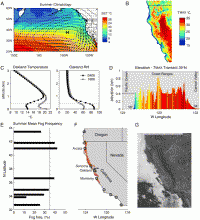Climatic context and ecological implications of summer fog decline in the coast redwood region

Biogeographical, physiological, and paleoecological evidence suggests that the coast redwood [Sequoia sempervirens (D. Don) Endl.] is closely associated with the presence of summer marine fog along the Pacific coast of California. Here we present a novel record of summer fog frequency in the coast redwood region upon the basis of direct hourly measurements of cloud ceiling heights from 1951 to 2008. Our analysis shows that coastal summer fog frequency is a remarkably integrative measure of United States Pacific coastal climate, with strong statistical connections to the wind-driven upwelling system of the California Current and the broad ocean temperature pattern known as the Pacific Decadal Oscillation. By using a long-term index of daily maximum land temperatures, we infer a 33% reduction in fog frequency since the early 20th century. We present tree physiological data suggesting that coast redwood and other ecosystems along the United States west coast may be increasingly drought stressed under a summer climate of reduced fog frequency and greater evaporative demand.
Johnstone, J. A., and T. E. Dawson. 2010. Climatic context and ecological implications of summer fog decline in the coast redwood region. Proceedings of the National Academy of Sciences 107:4533–4538.
